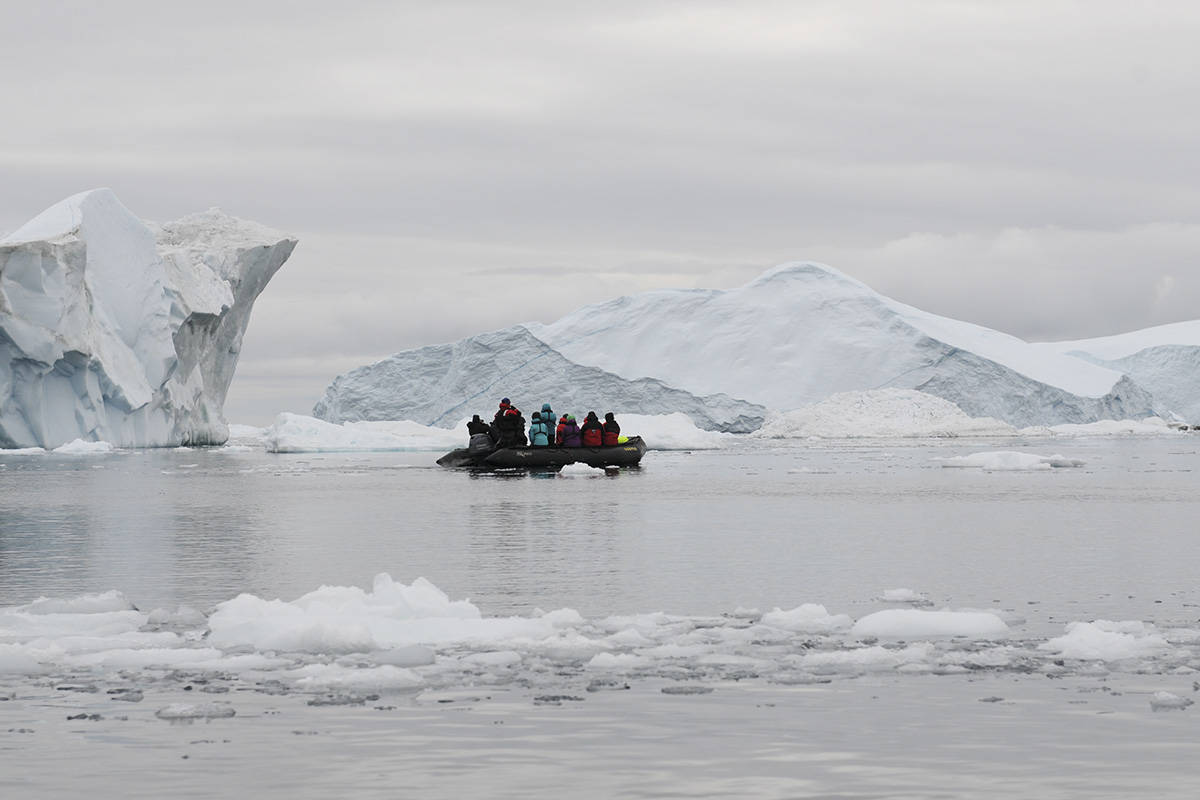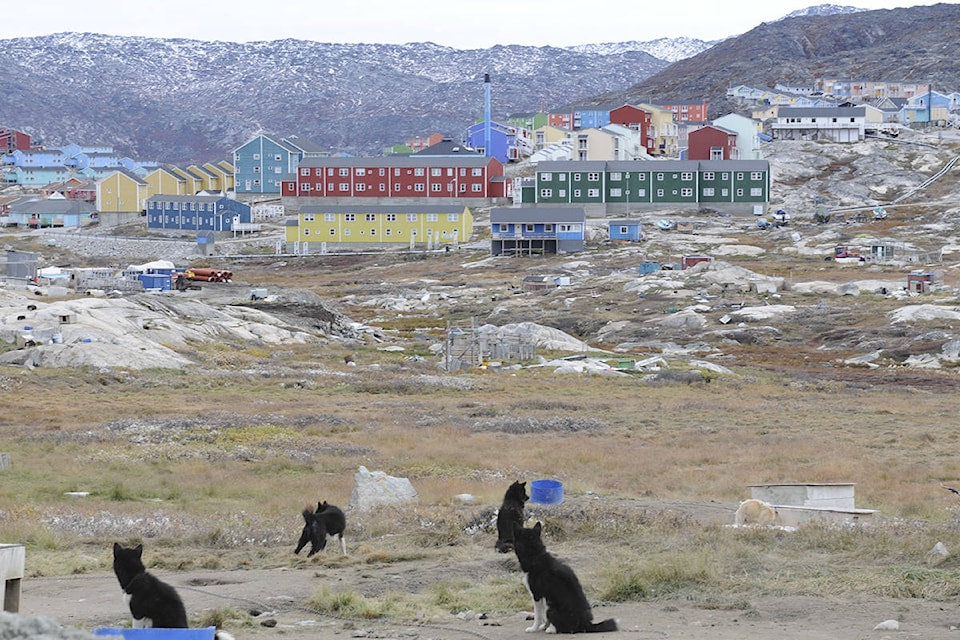Marina McCready | Special to the News
How exciting to wake up anchored off the Greenland community of Ilullissat, a tidy collection of very colourful buildings huddled amongst dark bedrock. We went ashore bright and early and landed at a dock in a small protected harbour crammed with fishing boats.
Once ashore I walked up the very narrow streets trying hard not to get killed by some very aggressive local drivers. The town is much larger and brighter than the Canadian Arctic communities we had visited. I headed straight for the famous Illulissat Icefjord, a UNESCO World Heritage Site. The road led past hundreds of sled dogs chained up on the outskirts of town. I learned later that there are almost as many dogs as people (population 4,500) in Illulissat. It seems the tradition of using dogs to pull qamutiks (sleds) is still alive and well here.
After passing the dogs, I came to the long winding boardwalk that leads across the tundra to the icefjord. True to its name, the fjord is literally jammed with ice that calves off the Sermeq Kujallek glacier at a volume of 35 cubic kilometres annually. This is one of the few locations where the Greenland ice sheet reaches tidewater. The ice bergs here will be seen off the coast of Newfoundland in two or three years. First, they are pushed north in the warm western Greenland current before turning south and heading down the east coast of Baffin Island in the cold Baffin Island current.
Back in town the must-see place was the Knud Rasmussen Museum which is located in the family home where he was raised. His mother was half Inuk and he was fascinated by that culture. He also had a thirst for exploration and did a total of seven expeditions in the Arctic. His fifth was the greatest as he travelled by dog team all the way from Greenland to Alaska. Along the way he studied Inuit, including their origins, traditions, ethnography, biology and archaeology. The result was a 10-volume journal which was published and much studied over the years. He may have contributed more to our knowledge of Inuit but he died of food poisoning on his seventh expedition in 1933 at the age of 54.
Before leaving Illulissat we were taken out in zodiacs to explore some of the incredible icebergs in the bay. There was every size and shape imaginable but it was the huge ones that really caught my imagination. I could have stayed out there for many hours but our ship had already pulled anchor and steamed out to meet us so we had to get going.
The next day after travelling south down the coast of Greenland we turned into beautiful Itellic Fjord for a shore excursion. What a gorgeous place: amazing pink striped granite rocks, little tarns that were surprisingly not frozen, red foliage everywhere, Arctic cotton blowing in the wind, and magnificent mountains. There were also a couple of Thule-era sod hut remains to look at.
Prior to pulling anchor, passengers were invited to go for a polar dip off the platform where we normally load in and out of the zodiacs. Many people opted to take the plunge and I was reminded of something my mom used to say: “too soon old and too late smart.”
That evening there was a variety show in the lounge and anyone on the ship could participate. A distinguished looking female passenger received a standing ovation for a beautiful piano piece and two of the ship’s crewmen were hits with their fantastic singing. There were some really funny acts as well — one of which was a skit about what happened to the men’s dangly bits when they took the polar plunge. Enough said.
Overnight we travelled down Sondrestrom Fjord and anchored off our disembarkation point of Kangerlussuaq. We left the ship very early as many of us had signed up for a trip to the Greenland Ice Sheet. This turned out to be the best animal sighting adventure of the entire trip. We travelled inland on a narrow gravel road for about two hours. Along the way we saw arctic hares, arctic foxes, caribou, ptarmigan and two herds of muskoxen.
Once we reached the ice sheet our driver’s only advice was to stick to the areas where we could see footprints in the fresh snow – otherwise we could easily fall down a crevasse. He was pretty casual about it and didn’t accompany us, but we all made it back alive. I was wildly excited to be walking around on the second largest ice sheet in the world at 1.7 million square kilometres. It is over three kilometres deep in places and its weight has compressed the centre of Greenland below sea level. Research shows that the ice sheet is shrinking and the yearly loss of ice has doubled since 2003. As I happily trudged around on the beautiful undulating glacial ice I alternately thought “I can’t believe I’m here” followed by “one day this will all be gone.”
Once back at the airport which was built by Americans during World War 2 we took a chartered flight to Toronto. It was 30 C when we arrived at Pearson International Airport and we were still dressed for walking on ice where it had been about -3 C. I thought I was going to melt into a puddle before I made it to my hotel room. It was hard to wrap my mind around the fact that just that morning I had been walking on the Greenland ice sheet and now my awesome adventure had come to an abrupt end in sweltering Toronto.
I wanted nothing more than to immediately fly north and do it all again.
Marina McCready is a Whitehorse based freelance writer and photographer. This piece is last in a five-part series.

